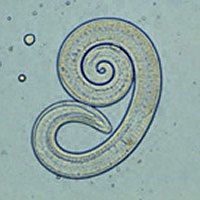
Photo from wikipedia
There is little or even no data in the global literature on the distribution of different species of Trichinella in the individual parts of the diaphragms and tongues in infected… Click to show full abstract
There is little or even no data in the global literature on the distribution of different species of Trichinella in the individual parts of the diaphragms and tongues in infected pigs. This is of particular importance from the food safety point of view and for the conduct of routine testing of pig carcasses for Trichinella as well as epidemiological surveys. Therefore, the aim of the present study was to evaluate the distribution of Trichinella spiralis (T. spiralis), Trichinella britovi (T. britovi), and Trichinella pseudospiralis (T. pseudospiralis) ML in various parts of the diaphragm (the pillars, costal, and sternal part) and the distribution of encapsulated species of Trichinella (T. spiralis and T. britovi) in various parts of the tongues (the tip, body, and root) of experimentally infected pigs. The diaphragm pillars were the most heavily parasitized part of the diaphragm both in groups of pigs infected with particular species of Trichinella and in groups of pigs presenting different levels of infection; however, statistical differences were observed only in the group of pigs with moderate (21–35 larvae per gram-lpg) or moderately high (35–55 lpg) intensity of Trichinella spp. infection in the entire diaphragm. In all groups of pigs, regardless of the infecting Trichinella species or infection level, larvae showed a homogeneous distribution on both sides of the diaphragm and excluding those of T. pseudospiralis, also in all three parts of the tongue. Histological examination showed features of a differential inflammatory response around larvae of the different Trichinella species. This study confirmed that for mandatory examination of pig carcasses using a pooled-sample digestion assay in which each pig is intended to be represented by a 1 gram sample taken from the diaphragm pillars, if that tissue is not available, the mass of the sample taken from the remaining diaphragm parts (costal or sternal) should be at least double that from the pillars. Histological findings confirmed that the inflammatory pattern of pig muscles varies depending on the Trichinella species triggering the infection and is less intense in the case of infections with T. pseudospiralis than in infections with encapsulated species of Trichinella (T. spiralis and T. britovi).
Journal Title: Frontiers in Veterinary Science
Year Published: 2021
Link to full text (if available)
Share on Social Media: Sign Up to like & get
recommendations!